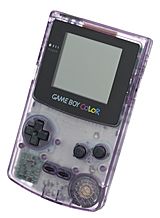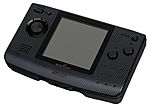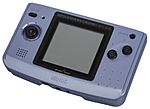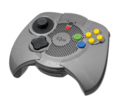Fifth generation of video game consoles facts for kids
The fifth generation of video games was an exciting time for gaming, lasting from about 1993 to 2006. During this period, video games and consoles changed a lot! The biggest change was moving from flat, 2D graphics to amazing 3D worlds. Also, games started coming on CDs instead of cartridges.
The most popular home console of this era was the Sony PlayStation. The Nintendo 64 came in second, and the Sega Saturn was third. For handhelds, the Game Boy Color was by far the most successful.
Here are some cool new things that came with these consoles:
- 3D graphics: Games started looking much more real with 3D shapes and textures.
- CD games: Games were stored on CDs, which could hold much more data (like 650 MB) than old cartridges.
- Better sound: You got CD-quality music and speech in games.
- Full-motion video: Games could show pre-made animated movies or real-life video clips.
- Analog controllers: These new controllers let you move characters more smoothly in 3D worlds.
- Higher resolution: Games looked sharper on your TV.
- More colors: Consoles could show millions of colors, making games look vibrant.
This generation also saw the first steps into online gaming, with some systems offering ways to connect to the internet.
For handheld gaming, many different devices came out, but most didn't last long. The Sega Nomad and Nintendo Virtual Boy were stopped quickly. The Game Boy Color from Nintendo became the clear winner.
There was a bit of overlap with the next generation of consoles. The fifth generation officially ended when the PlayStation (specifically its smaller version, the "PSOne") was stopped in 2006.
Contents
History of Gaming Changes
The Big Jump to 3D
The 32-bit and 64-bit era is famous for the rise of games with full 3D graphics. Before this, some games had used 3D shapes, like Star Fox on the Super NES. But in this era, many game makers started turning their 2D games into 3D adventures on consoles.
Around 1996, 3D games really took off. Games like Super Mario 64 on the Nintendo 64 and Tomb Raider on the PlayStation showed off amazing 3D worlds. These games were a huge hit and changed how the industry thought about game design. 3D became the main focus, and games slowly moved away from cartridges to CDs. This was because CDs were cheaper to make and could hold much more game content.
CDs vs. Cartridges
Nintendo decided to stick with cartridges for the Nintendo 64, even though most other companies were using CDs. Nintendo said cartridges meant faster loading times and less piracy (people copying games illegally). However, cartridges were also much more expensive to make. This meant Nintendo could charge more money for games, which some game developers didn't like.
This choice started a big debate among gamers: which was better, CDs or cartridges?
Here's why CDs were popular:
- Huge storage: CDs could hold a lot more game content.
- Cheaper to make: This made games less risky for publishers.
- Lower prices: Games could be sold for less money.
- Faster production: It took less time to make CDs.
But cartridges had their own benefits:
- No loading screens: Games started instantly.
- Less reliance on console memory: Data could be loaded as you played.
Nintendo even made an ad showing a Space Shuttle (cartridges) next to a snail (CDs) to show how much faster cartridges were!
Despite Nintendo's arguments, almost every other console used CD-ROMs. Because CDs offered more storage and cost less, many game developers started making games for the PlayStation instead of the Nintendo 64. A famous example is the Final Fantasy series. Final Fantasy VII was planned for the N64, but because of its huge story and graphics, it moved to the PlayStation. Before this, Final Fantasy games were always on Nintendo consoles.
Main Consoles of the Era
The fifth generation had many different consoles trying to win over gamers.
The 3DO Interactive Multiplayer was one of the first, released in 1993. It had a lot of hype but was very expensive (around $700!). It didn't last long, but it still sold 2 million units.
The Sega Saturn came out in Japan in 1994 and in North America in 1995. It was very popular in Japan. But in America and Europe, a messy launch and a higher price ($399 compared to PlayStation's $299) made it less successful.
The PlayStation, released in late 1994, was the biggest winner of this generation. It got a lot of support from game developers and was marketed to an older audience (20-30 year olds). It was the first home console to sell over 100 million units worldwide!
The Nintendo 64, first called "Ultra 64," came out in 1996. It was delayed, and its use of expensive cartridges made some game developers avoid it. However, Nintendo made many popular games for it, like Super Mario 64, which helped the N64 sell well in the United States. But it still couldn't beat the PlayStation.
Other Consoles and Add-ons
Many other consoles were released during this time, but they weren't as well-known or didn't sell very well.
-
FM Towns Marty, made by Fujitsu. Released in Japan in 1993.
-
Amiga CD32, made by Commodore. Released in 1993.
-
PC-FX, made by NEC. Released in Japan in 1994.
-
Playdia, made by Bandai. A console with simple multiple-choice games. Released in Japan in 1994.
-
Casio Loopy, made by Casio. Released in Japan in 1995, aimed at girls.
-
iQue Player, a smaller Nintendo 64 released only in China in 2003.
Some consoles also had add-ons to make them more powerful or add new features:
-
32X, an add-on for the Sega Genesis/Mega Drive. Released in 1994.
-
Atari Jaguar CD. Released in 1995.
-
Nintendo 64DD. Released only in Japan in 1999.
After the Console Wars
By the end of 1995, the fifth generation was mostly a fight between the Sony PlayStation, Sega Saturn, and the upcoming Nintendo 64. Many other consoles had already failed. At first, sales for the new consoles were slow, and some wondered if they would ever be as popular as the older ones.
But in 1996, things changed! The Saturn, PlayStation, and Nintendo 64 all saw a big jump in sales.
The Sega Saturn struggled because of bad marketing and not enough games outside of Japan. Sega also made a mistake by releasing the Saturn early in the U.S. without telling retailers or game developers. This made many stores angry and hurt sales.
The Nintendo 64 was released a year later than its rivals. By then, Sony's PlayStation was already very strong. The N64's use of cartridges also made some developers unhappy because of the cost and limited space. However, the Nintendo 64 was still a success, especially in the United States. It sold over 32 million units worldwide. It had many famous games like Star Fox 64, Mario Kart 64, and The Legend of Zelda: Ocarina of Time. Even with its success, the N64 couldn't beat the PlayStation's lead.
By 1997, many homes in America had video game consoles.
Changes in the Gaming World
After this generation, some big gaming companies saw major changes.
Atari
Atari Corporation couldn't recover from its losses and merged with another company in 1996. The Atari name almost disappeared from gaming. Later, in 1999, all rights to the Atari Jaguar were made free for anyone to use. This allowed fans to create new games for it.
Sega
Sega's struggles with the Saturn, along with earlier console problems, set them up for more difficulties in the next generation of consoles.
Home Consoles: A Quick Look
| Name | 3DO Interactive Multiplayer | Atari Jaguar | Sega Saturn | PlayStation | Nintendo 64 |
|---|---|---|---|---|---|
| Manufacturer | The 3DO Company | Atari | Sega | Sony | Nintendo |
| Image(s) |
|
 |
 |
||
| Top: Panasonic FZ-1 R·E·A·L Bottom: GoldStar GDO-101M |
Atari Jaguar and controller | Top: North American Saturn Model 1 Bottom: Japanese Saturn Model 1 |
Top: Original PlayStation Bottom: Smaller PSone |
Nintendo 64 | |
| Launch Price (USD) | $699.99 (1993) | $249.99 (1993) | $399.99 (1995) | $299.99 (1995) | $199.99 (1996) |
| Release Date | October 4, 1993 (NA) | November 23, 1993 (NA) | November 22, 1994 (JP) | December 3, 1994 (JP) | June 23, 1996 (JP) |
| Game Storage | CD-ROM | Cartridge, CD-ROM (with add-on) | CD-ROM, Cartridge | CD-ROM | Cartridge, Magnetic disk (with add-on) |
| Best-Selling Game | Gex (1 million+) | Alien vs Predator (50,000+) | Virtua Fighter 2 (1.7 million in Japan) | Gran Turismo (10.85 million) | Super Mario 64 (11.62 million) |
| CPU | ARM60 (32-bit) @ 12.5 MHz | "Tom" & "Jerry" (32-bit) @ 26.59 MHz | 2x Hitachi SH-2 (32-bit) @ 28.63 MHz | LSI LR333x0 (32-bit) @ 33.8688 MHz | NEC VR4300 (64-bit) @ 93.75 MHz |
| Memory | 3 MB RAM | 2 MB RAM | 4.5 MB RAM | 3.587 MB RAM | 4 MB RDRAM (8 MB with Expansion Pak) |
| Video | 3D polygons, textures, 24-bit color | 3D polygons, textures, 24-bit color | 3D polygons, textures, 24-bit color | 3D polygons, textures, 24-bit color | 3D polygons, anti-aliasing, 24-bit color |
| Audio | 16-bit sound, CD-DA audio | 16-bit PCM sampling | 32 sound channels, 16-bit PCM, CD-DA | 24 ADPCM channels, 16-bit, CD-DA | Variable channels, 16-bit, 44.1 kHz |
| Online Services | No | Limited (modem) | Yes (NetLink, SegaNet) | Limited (Lightspan, i-mode) | Limited (SharkWire, Randnet) |
Worldwide Sales Standings
Here's how the main consoles sold around the world:
| System | Units Sold |
|---|---|
| PlayStation | 102.49 million |
| Nintendo 64 | 32.93 million |
| Sega Saturn | 9.26 million |
| 3DO | 2 million |
| 32X | 800,000 |
| PC-FX | 400,000 |
| Atari Jaguar | 250,000 |
| Amiga CD32 | 100,000 |
| FM Towns Marty | 45,000 |
| Apple Bandai Pippin | 42,000 |
From 1996 to 1999, Sony had the biggest share of the worldwide market (47%), followed by Nintendo (28%), and Sega (23%).
Sega stopped making the Saturn in 1998. The Nintendo 64 was replaced by the GameCube in 2001, but production continued until 2004. The PlayStation, however, got a new, smaller design called the PSone, which kept it popular even after the PlayStation 2 came out. PlayStation production finally stopped in 2006.
Handheld Systems
This era also had many handheld gaming devices.
Handheld Comparison
| Name | Game Boy Color | Neo Geo Pocket / Neo Geo Pocket Color |
|---|---|---|
| Manufacturer | Nintendo | SNK |
| Console |  |
  |
| Release Dates | October 21, 1998 (JP) | October 28, 1998 (JP) (Neo Geo Pocket) |
| Discontinued | March 23, 2003 | June 13, 2000 (NA/EU) (Neo Geo Pocket Color) |
| Logo |  |
|
| Launch Prices | US$69.99 | ¥7,800 (Neo Geo Pocket) |
| Media | Game Boy Game Pak | ROM cartridge |
| Best-Selling Game | Pokémon Gold and Silver (23 million) | ? |
| CPU | Sharp LR35902 @ 4.19/8.38 MHz | Toshiba TLCS900H (16-bit) @ 6.144 MHz |
| Memory | 32 KB RAM, 16 KB VRAM | 12 KB RAM (900H), 4 KB RAM (Z80) |
| Color | 32,768 colors; 10, 32 or 56 at once | 4,096 colors, 146 at once |
| Audio | Stereo (headphones), 4 channels | Stereo (headphones), 4 channels |
| Backward Compatibility | Game Boy | None |
| Resolutions | 160 × 144 | 160 × 152 |
| Units Sold | 118.69 million (includes Game Boy) | 2 million (Neo Geo Pocket Color) |
Other Handhelds
-
Genesis Nomad
Released in 1995 in the U.S. only. -
Virtual Boy
1995–1996.
Awesome Games of the Era
This generation brought us many classic and important games:
- Castlevania: Symphony of the Night (PlayStation, Saturn): A fantastic 2D game that showed 2D games were still cool. It helped create the "Metroidvania" style of game.
- Crash Bandicoot (PlayStation): Crash became a popular mascot for PlayStation, like Mario for Nintendo.
- Final Fantasy VII (PlayStation, PC): This game was a huge hit and used amazing full-motion videos. It helped make Japanese role-playing games (RPGs) popular in the U.S.
- GoldenEye 007 (Nintendo 64): This game made first-person shooter games popular on consoles. It also introduced the idea of scoped sniper rifles in games.
- Gran Turismo (PlayStation): This racing game was different because it focused on realistic driving physics and had many real-world cars.
- The Legend of Zelda: Ocarina of Time (Nintendo 64): Many people call this one of the greatest games ever! It brought the Zelda adventures into a huge 3D world and introduced the "Z-targeting" system for fighting.
- Metal Gear Solid (PlayStation, PC): This game was loved for its deep story, great voice acting, and movie-like feel.
- Pokémon Red and Blue (Game Boy): These games were a massive success for the Game Boy and made Pokémon a worldwide phenomenon. They sold about 31 million copies!
- Resident Evil (PlayStation, Saturn, PC) and Silent Hill (PlayStation): These games helped make the "survival horror" genre popular, where you try to survive scary situations.
- Super Mario 64 (Nintendo 64): This is considered one of the best games ever! It was famous for its amazing camera system, smooth 360-degree control, and open-world design. It sold 11.62 million copies.
- Super Smash Bros. (Nintendo 64): This game was a new idea for Nintendo, letting characters from different Nintendo games fight each other in a fun party style.
- Tekken 3 (PlayStation): This fighting game is often called one of the best fighting games of all time.
- Tomb Raider (PlayStation, Saturn, PC): This game popularized many elements seen in later games, and its main character, Lara Croft, became super famous.
- Tony Hawk's Pro Skater 2 (Nintendo 64, PlayStation, PC): This skateboarding game was highly praised and is considered one of the greatest games ever made.
- Virtua Fighter (Arcade, Saturn, PC): This game created the 3D fighting game genre.
See also
 In Spanish: Videoconsolas de quinta generación para niños
In Spanish: Videoconsolas de quinta generación para niños
- 1990s in video games
- Fourth generation of video game consoles
- Sixth generation of video game consoles
- The 3DO Company
- Playdia





















